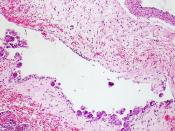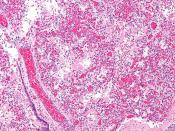Adult respiratory distress syndrome, also known as congestive atelectasis or shock lung, is the rapid malfunction of the lungs. The ability to take in oxygen severely weakens and usually is associated with the malfunction of other organs. The condition has to do with extensive pulmonary inflammation and small blood vessel injury in affected organs. ARDS is the result from widespread acute injury to the alveolar capillary membrane. One can be diagnosed with ARDS by intensive trauma, surgery, head injuries, or shock. Although it can become very severe, there are many ways of treatment. There are some minor symptoms that come with ARDS that may be noticed so that one can be treated immediately to prevent further damage.
To understand ARDS, it is important to review how the lungs work. Air, which contains oxygen, is inhaled through the nose and mouth, and passes into the windpipe (trachea). From the trachea, air flows through tubes called bronchi into microscopic air sacs called alveoli.
Very small blood vessels (capillaries) are imbedded in the walls of these air sacs. Oxygen passes through the thin walls of the alveoli into the bloodstream. Carbon dioxide, a waste product of cellular function throughout the body, passes from the bloodstream into the alveoli and then is exhaled.
At the onset of ARDS, lung injury may first appear in one lung, but then quickly spreads to affect most of both lungs. Inflammation may irritate the injury because of the release of oxidants and lysosomal enzymes from activated leukocytes. The infection is caused by a variety of conditions that directly or indirectly cause the blood vessels to "leak" fluid into the lungs. ARDS affects these glassy pink membranes that line the insides of alveoli. The ability of the lungs to expand is severely decreased and damage to the air...


